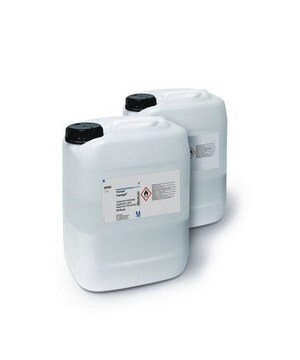1.02330
Cellulose microcrystalline
for thin-layer chromatography
Synonym(s):
Cellulose microcrystalline
About This Item
Recommended Products
material
cellulose matrix
plastic support
Quality Level
form
microcrystalline
autoignition temp.
232 °C
potency
>5000 mg/kg LD50, oral (Rat)
>2000 mg/kg LD50, skin (Rabbit)
feature
binder Organic Polymer
fluorescent indicator: no
packaging
pkg of 500 g
technique(s)
thin layer chromatography (TLC): suitable
particle size
5-40 μm
pore size
60 Å medium pore diameter
pH
5-7.5 (20 °C, 100 g/L in H2O, slurry)
transition temp
flash point 260 °C
density
1.5 g/cm3 at 20 °C
bulk density
70‑400 kg/m3
storage temp.
2-30°C
SMILES string
O1[C@H](C(C(C(C1CO)O)O)O)O[C@@H]2C(OC(C(C2O)O)O)CO
InChI
1S/C12H22O11/c13-1-3-5(15)6(16)9(19)12(22-3)23-10-4(2-14)21-11(20)8(18)7(10)17/h3-20H,1-2H2/t3?,4?,5?,6?,7?,8?,9?,10-,11?,12+/m1/s1
InChI key
GUBGYTABKSRVRQ-WFVLMXAXSA-N
General description
Application
- Study of the influence of cellulose derivatives on physical and analytical attributes of a drug product belonging to BCS class II.: This research explored the impact of cellulose microcrystalline on the physical properties and analytical performance of a class II drug product. The findings demonstrated the role of cellulose microcrystalline in enhancing the stability and dissolution rate of the drug, contributing to improved bioavailability (Domoslawska et al., 2018).
- Application of ethyl cellulose, microcrystalline cellulose and octadecanol for wax based floating solid dispersion pellets.: The study investigated the use of microcrystalline cellulose in the formulation of wax-based floating pellets. The results highlighted its effectiveness in controlling the release profile and enhancing the floating properties of the drug delivery system (Yan et al., 2016).
- Modelling of porosity and waterfronts in cellulosic pellets for understanding drug release behavior.: This paper presented a model for analyzing the porosity and water penetration in cellulosic pellets, providing insights into the drug release mechanisms. The study emphasized the crucial role of microcrystalline cellulose in modulating drug release profiles (Gomez-Carracedo et al., 2010).
- Fast dissolving films made of maltodextrins.: The research explored the incorporation of microcrystalline cellulose in fast-dissolving films, demonstrating its impact on film integrity and dissolution rates. The findings support the use of microcrystalline cellulose in enhancing the performance of oral thin films (Cilurzo et al., 2008).
- Compressibility of floating pellets with verapamil hydrochloride coated with dispersion Kollicoat SR 30 D.: This study evaluated the compressibility and mechanical properties of floating pellets containing microcrystalline cellulose, showing its role in maintaining pellet integrity and controlled drug release (Sawicki & Lunio, 2005).
Analysis Note
d 50 (laser diffraction, size distribution): 10 - 30 µm
d 90 (Laser diffraction, size distribution): 30 - 60 µm
Related product
Storage Class
11 - Combustible Solids
wgk_germany
WGK 1
flash_point_f
Not applicable
flash_point_c
Not applicable
Certificates of Analysis (COA)
Search for Certificates of Analysis (COA) by entering the products Lot/Batch Number. Lot and Batch Numbers can be found on a product’s label following the words ‘Lot’ or ‘Batch’.
Already Own This Product?
Find documentation for the products that you have recently purchased in the Document Library.
Customers Also Viewed
Our team of scientists has experience in all areas of research including Life Science, Material Science, Chemical Synthesis, Chromatography, Analytical and many others.
Contact Technical Service


